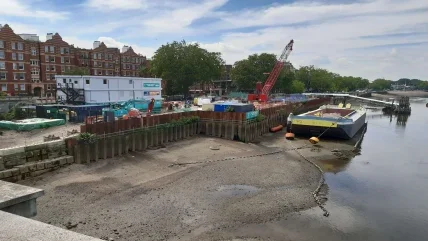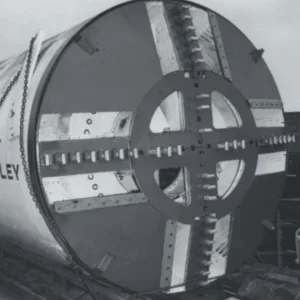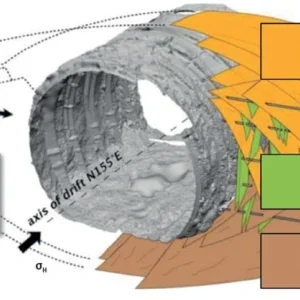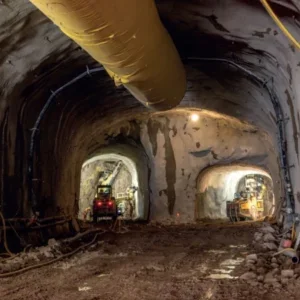
If proof were ever needed of the win-win nature of industry placements, look no further than Kate Cooksey. She earned her MEng in civil engineering from Cardiff University in 2007, and has stayed loyal to her employer and sponsor Morgan Sindall for nearly 16 years. Today, she is based in the firm’s Birmingham office as senior engineering manager working on HS2. Not content with such sterling service, she has also just taken up the chair of the British Tunnelling Society (BTS).
Cooksey’s passage into tunnelling has not been a direct progression. As a youngster, she did a placement with an architectural practice but found it not to her liking. It was only after one of the partners suggested she spend some time with the practice’s geotechnical engineers that she realised engineering was to be her future. Shortly after, in 2002, she enrolled on the MEng course in civil engineering at Cardiff University.
While there, Cooksey became president of the university’s civil engineering society. It was not long before she invited an engineer from Morgan Sindall to come and talk to the students on the uses of underground space. It proved to be a turning point and sparked her love of underground engineering.
“The talk really captured my interest and in the third and fourth year of my course I was invited to do a placement with Morgan Sindall during which I worked on numerous exciting projects, including the National Grid’s Croydon cable tunnel. This led to a formal job offer in 2007 in the tunnels division of Morgan Sindall and I was captured.”
Promoting Tunnelling
In parallel to her work in tunnelling, Cooksey has promoted the profession tirelessly, particularly the academic side. After only six months in the industry, she wrote a paper addressing how the BTS could get more young people into the profession and support them once they were in. And on her own initiative, in 2008, she conceived and set up the BTS Young Members’ Committee (BTSYM) which she chaired for the first two years.
As well as being an important UK-wide development, the formation of BTSYM set off an international movement establishing young members’ tunnelling societies in a significant number of ITA member nations. Cooksey also worked with Petr Salak to pitch the proposal for the establishment of the ITA young members’ committee. As if running BTSYM was not enough, she was also a co-opted member on the BTS main committee as well as a member of its education sub-committee.
Attracting youngsters to join BTSYM and into the industry is crucial. To help provide more formal routes into tunnelling and reduce the burden on employers, Cooksey worked with colleagues from the BTS Education Sub-committee to encourage universities to establish an advanced learning course in tunnelling. The initiative led to the introduction of the MSc in Tunnelling and Underground Space at the University of Warwick where Cooksey guest-lectures every year, sits on its steering board and examines module feedback. The BTS also has ongoing input into the course.
Accolades
But more achievements were to come. After passing her ICE chartership in 2012, Cooksey won the ICE Quest Eloise Plunkett award which she used to go to the US, visiting RETC and projects such as East Side Access, Ground Zero and other civils’ sites. It was during this visit that she met with both the Tunnelling Association of Canada (TAC) and ICA of SME to foster the initiation of their own young members’ groups, both of which are now well established.
“It really is quite incredible to see how the young members’ groups have grown globally,” she says. “I’m immensely proud to see that the enthusiasm of young people in our industry to learn and progress has such a powerful outlet via the ITA young members [ITAym].”
Further recognition came in 2012 when ICE and WES awarded Cooksey the award for Best Newly Chartered Female Engineer; she also achieved a place on Management Today’s prestigious ’35 Women Under 35’ list.
Attaining the BTS chair is a further highlight for the 35-yearold engineer. But what exactly does it mean for her? She replies: “I started my journey with BTS 10 years ago and I’m immensely proud of having been given the reigns of a body I’ve been part of for a decade. I hope that I can use what has shaped my career to help foster the careers of others.”
Adapting Post-Covid
Perhaps one of the most pressing issues Cooksey will have to deal with as Chair is how tunnelling will emerge from the ongoing Covid-19 crisis. She says: “I’m amazed at how resourceful both civil and tunnel engineers have proved at this time. The industry has quickly adopted online working and conference calls which have very much resulted in business as usual. And I’ve been impressed with how some of our clients have dealt with this situation, especially in London, where half the challenge is how our members get to work.
“We are finding that a number of sites have returned to work, such as Thames Tideway, where tunnelling has restarted, so you can argue that we have already begun to emerge from the crisis.” The pandemic has also meant more BTS events are held online. “We moved some of our lectures online a number of years ago, partly because we wanted to allow those working on site to benefit from BTS events. The AGM was held online, we hosted a talk with the Australian Tunnelling Society online and are now looking at options over the coming months for our evening meetings’ programme.
“The other side of emerging from the pandemic is first, having a support network, and our members are really excellent at this: BTS is a family where everyone looks out for each other. Second, it is about being ready to continue to promote the benefits of underground space and how it can help provide a resilient society.”
Shaping the BTS
So, how will Cooksey try to shape the BTS? She explains: “Our aims and objectives are to advance the public’s knowledge and to be there for our members, providing them with opportunities, and bringing possibilities for people to come together. This includes doing more outreach to the regions.
“For some time now, the BTS has worked on various initiatives. For example, we started the All-Party Parliamentary Group for Underground Space (APPGUS) and then merged it into a broader group called the All-Party Parliamentary Group for Infrastructure (APPGI). This has now become a joint programme with the ICE and we hold various events which aim to help the civil engineering sector engage with government.
One of the more pressing problems Cooksey will undoubtedly have to tackle is how to get more youngsters into engineering generally and tunnelling specifically. It is a subject she is passionate about and has already spoken on the topic in the Houses of Parliament.
“We can cover things like degree apprenticeships, funding and social media, but it’s not just about focusing on young people,” she explains. “It’s more about influencing parents, teachers and careers professionals who shape the perceptions of the young in terms of engineering as a career choice. If parents and others don’t understand the engineering sector the chances are they will advise the kids on professions they are more familiar with, such as medicine or accountancy.”
Getting the Message Out
Inspiring young minds about the possibilities of engineering also requires communications skills and selfpromotion, areas which engineers may not generally have focused on in the past. Can they rise to the challenge?
“It is a myth that engineers are poor communicators” says Cooksey. “The irony is that we wouldn’t be building the structures we are building if we were such bad communicators. Maybe our way of communicating is different to that of other sectors? I think a lot of this is about how we get others to communicate our message and realising that we, as a profession, need to do a fair amount of that ourselves.
“Over the past few years, we have had some pretty major projects that have highlighted the role of the engineer, such as Crossrail, the London Olympics, Thames Tideway and HS2,” she says.
“These projects are a lot more about engineering than previous projects. When I joined the industry, it was more about building structures. Now we have these major projects in which the engineering dominates and there is less evidence of architectural input.
As only the first woman to take up the BTS chair, and with WSP’s Rachel Skinner soon to become ICE president (November 2020), is the prominent female engineer at last becoming a fact of life?
“For me it’s not necessarily about being male or female but are they right for the role. How do they tackle problems and challenges? Rachel has great ideas and I’m really excited over what she is going to do.
“I started in industry at the time of the first female president of the ICE (Jean Venables) which was really encouraging.
While there are relatively few ladies in engineering, I think this is changing. The BTS for example, is beginning to get more balance and, as more BTS young members transition to the main committee, I am hoping we will start to see more females involved.”
Cooksey’s first year coincides with the 50th anniversary of the BTS and she looks forward to celebrating it appropriately. This includes publication of the BTS book on members’ tales, how the industry has developed and particularly about the people who make up the BTS.
Clearly, there is a lot on the plate of someone who has achieved so much at such a tender age. But her achievements indicate that, as with so much else, Cooksey will find these new challenges to be just another piece of cake.







